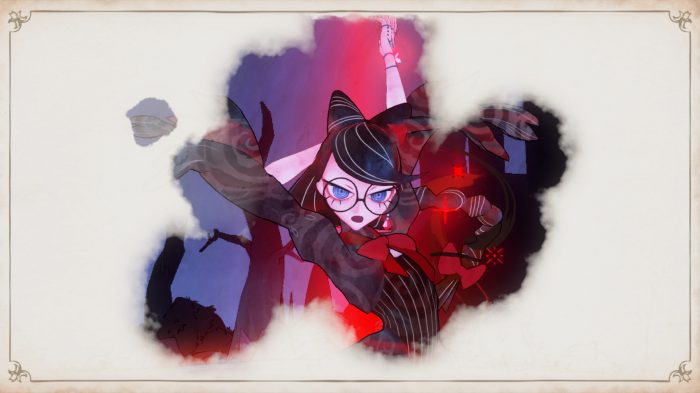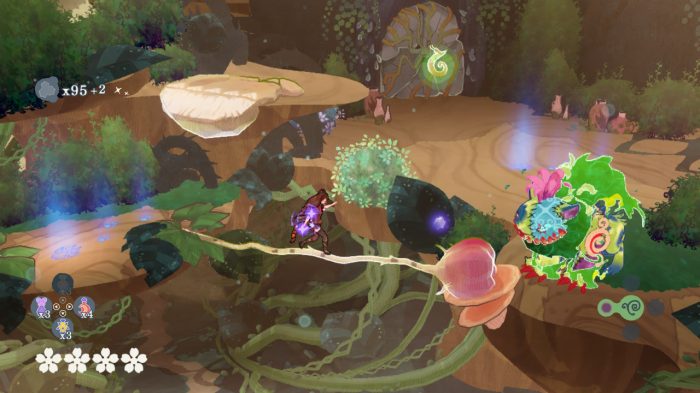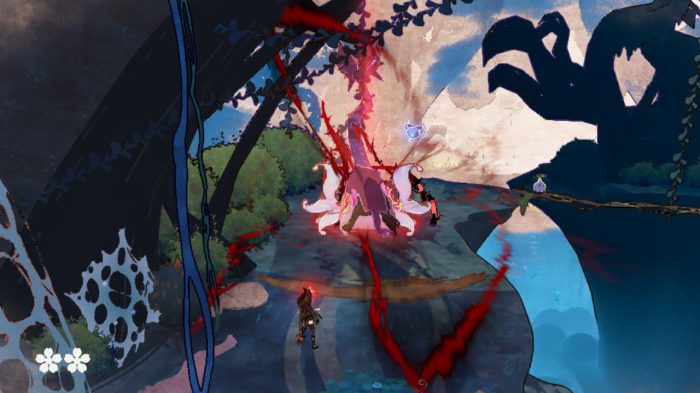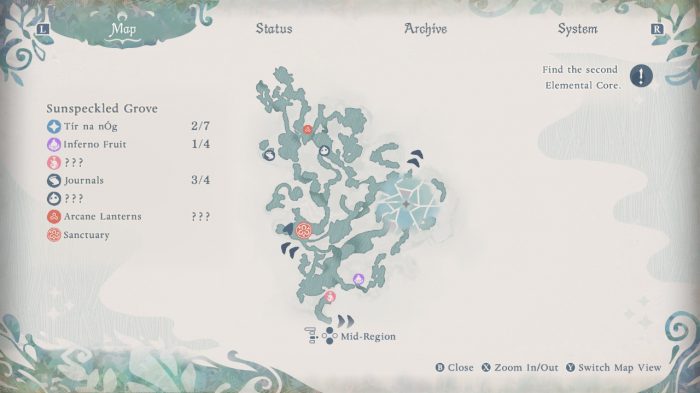Some of the best fairy tale books start in a similar manner: with a curious child answering a call to adventure.
Taking inspiration from these fairy tales in more than one way, Bayonetta Origins: Cereza and the Lost Demon brings an entirely new flavour to the Bayonetta series in the form of a spin-off that isn’t afraid of mixing different genres and trying unique ideas. It is a surprising release that didn’t have the same anticipation as Bayonetta 3 did (after all, it was announced and released within a three-month window), but it is a game that explores the origins of the Umbra Witch in a clever and creative manner.

The main adventures of Bayonetta Origins are centered on a much younger version of Bayonetta. Taking place many years before any of the games from the original trilogy, Origins presents Cereza, a witch-in-training that, when it comes to both power and personality, feels almost like the complete opposite of the Bayonetta we know so far. Shy, frightened, clumsy, and almost completely inept at the Umbra arts, Cereza is a suffering child that has to deal with terrible impositions that have taken place as a consequence of her birth condition.
Due to the fact that she is the daughter of an Umbra Witch and a Lumen Sage (opposite faction forces in the Bayonetta universe), Cereza has been banned forever from the Umbra Witches village, while her mother has been imprisoned for life. Now, despite being trained by another castaway witch called Morgana, Cereza finds herself powerless upon learning that her mother is about to be dragged to a faraway prison, from where she will probably never leave. Hopeless, she decides to enter the dangerous Avalon Forrest in an attempt to search for a mysterious source of power, which may be just what she needs in order to rescue her mother.
To hell with this unlikely friend!

Guided by a mysterious white wolf, Cereza finds herself trapped in Avalon Forrest, which she discovers to be a dangerous place inhabited by mischievous faeries. Alone, she couldn’t really stand a chance to survive through the night, but she finds herself an unlikely ally after trying to use her Umbra spells to summon a demon from Inferno. Despite half-failing at performing the spell, she summons Cheshire, a powerful cat-like creature that she can’t really control. Instead of returning to Inferno, though, the monster gets stuck inside Cereza’s doll, and is obliged to help Cereza, so they both can find a way back home.
While summoning and using demons during combat have been a staple in the Bayonetta series (something that has been considered expanded in Bayonetta 3), the way it happens in Bayonetta Origins is somewhat unique when compared to other games in the franchise. Here, Cheshire isn’t just a tool to be used only in combat. On the contrary, you have total freedom to summon and control Cheshire directly most of the time. Consequently, this unlikely ally becomes a fundamental element that is extremely important in combat, exploration, as well as in puzzle-solving.

It’s on top of that basic premise that Bayonetta Origins presents and develops a concept that isn’t explored too frequently in games: a ‘co-op game that you play alone’. Here, you have Cereza and Cheshire, two very different characters that have their own unique set of skills and limitations, and you need to control both at the same time in order to overcome different types of obstacles. The fabulous Brothers – a Tale of Two Sons is probably the most renowned game that explores a similar idea. Yet, Bayonetta Origins executes that while keeping and adapting some of the best aspects from the Bayonetta series, including the complex combat and thrilling action-focused gameplay.
In order to do that, Bayonetta Origins basically divides control between the Joy-Con. With the left stick, you control Cereza’s movements, and you can use her potions with the directional buttons and her Umbra spells with the left triggers. Cheshire’s controls, on the other hand, are relegated to the right Joy-Con, where the right triggers can be used for attacks, and the A, B, X, and Y buttons are used to change the demon’s current elemental affinities. This creates a very engaging gameplay dynamic where you need to pay attention to two characters at the very same time, while each one of them executes very different actions. The best thing about it? Bayonetta Origins explores that concept in creative and interesting ways.
A tale of two genres…

As mind-bending as the idea of controlling two characters can be, Bayonetta Origins does a good job of creating a nice learning curve, where each character starts simple, with just a handful of skills and movement options. As you progress, though, both Cereza and Cheshire will acquire a considerable number of new skills and powers, which always follow a multiple-purpose philosophy. This means that, with each new ability, also comes new cool options that can be used for combat, exploration, and puzzle-solving.
The way Avalon Forrest is constructed works as an open invitation for you to make the most of those skills. Even though you don’t have direct control over the camera, the game does a good job of always highlighting something interesting, slowly panning the camera depending on what is happening. During combat, for example, the game takes an almost top-down approach with its camera angles. As you explore the environments, though, you can notice the camera slowly changing to a more panoramic view. Thanks to that approach, the game manages to hide lots of secrets and shortcuts that you may only notice while looking at things from a specific positioning.

When you add that to Cereza’s and Cheshire’s aforementioned skills, you have a game that manages to blend more than one genre in a surprising and interesting way. That’s all thanks to how the game’s world is realized. While not an open environment per se, Avalon Forrest is constructed as a huge, interconnected, maze-like place. In the beginning, your traversal options are very limited, and you won’t be able to stray far from a mostly linear path. However, you will surely notice certain recurrent elements blocking additional pathways, such as plants, rocks, and even some weird mechanical apparatus.
As you progress through the game, you will be able to use Cheshire’s newly unlocked skills to interact with all these different obstacles. The map itself makes interesting use of that idea because you won’t really be simply going from one area to the other, without ever going back. Instead, your critical path will converge into the same locations more than once. As you unlock shortcuts to previous areas, you can revisit places with a much more powerful arsenal of skills that can be used to unlock new secrets and find secondary objects. In a way, it is as if Bayonetta Origins choose to blend together elements from a top-down Zelda with the interconnected exploration and secret solving of a Metroidvania.
Elemental, my dear Cheshire!

Another aspect of Bayonetta Origins that resembles elements from The Legend of Zelda games are the Tír na nÓg — faeries’ parallel dimensions that you must delve into in order to reclaim the territory. There are both small and big Tír na nÓg scattered through the entire Avalon Forrest, and they range from tiny challenge rooms (which are more often than not closed arenas focused on combat) to some enjoyable mini-dungeons that mix both combat and puzzle-solving.
Some of the best moments in Bayonetta Origins take place inside these bigger Tír na nÓg, as they do a great job of exploring the Cereza-Cheshire dynamic in clever ways. It is a shame that these moments are not as frequent as I’d like them to be — most of the Tír na nÓg are centered on combat, and while they aren’t bad at all, they can get a bit repetitive after a while. At least, Bayonetta Origins alleviates that by constantly presenting new types of enemies, some of which will demand specific skills in order to be dealt with effectively. As you progress, you can unlock different elemental modes for Cheshire, and you can use these powers to exploit enemies’ weaknesses.

In a way, it is a shame that Bayonetta Origins was released under the shadow of Bayonetta 3. Controversies over Bayo’s voice actress and the uneven performance of the third installment took away part of the brilliance of that title. In comparison, when you consider the overall package offered by Bayonetta Origins, you can easily say that it is a much more refined and cohesive experience — a game that opts to explore a very unique concept and does that in a surprisingly effective way. With a flawless performance, and a beautiful watercolor-fulfilled art style, Bayonetta Origins: Cereza and the Lost Demon is one of the biggest gaming surprises of 2023. A title that arrived out of nowhere, and surprised me in all the best ways.
Bayonetta Origins: Cereza and the Lost Demon £49.99
Summary
Unique and beautiful, Bayonetta Origins: Cereza and the Lost Demon isn’t afraid to mix elements from different genres to explore the somewhat unique concept of a ‘co-op game that you play alone’. The best part being that it executes that idea in an almost flawless manner.

